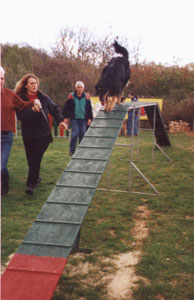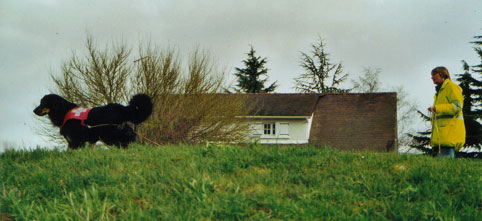 |
 |
|||||||||||||
|
||||||||||||||
|
|
A working dogThe Hovawart is a dog that can be intensively trained. He is a hard worker, intelligent and is quick on the uptake. He obeys his master willingly. Although he is easy to train he is not an automaton and will take the initiative when necessary. Not only can he partake in a vast variety of activities, but he can also be used as a security guard dog, in drug detection, in search and rescue, and, of course, as a guide dog.
AGILITYIn Agility the dog is required to clear a variety of obstacles. The aim is to show off his intelligence and his litheness.The educational and athletic aspects of the game help the dog's socialization. There should be a strong relationship between the master and his dog, so that they understand each other perfectly. Thus it is vital that all participants acquire a solid obedience training prior to doing this activity.
In Agility, the dogs are classed by their height at the withers: The Hovawart breed, male and female, fall into Category D.  The aim of Agility is to develop the relationship between the dog and his master. Winning is of secondary importance!
The aim of Agility is to develop the relationship between the dog and his master. Winning is of secondary importance!
 The Hovawart quickly understands what it's all about and as he loves to make his master happy, he'll be the one dragging you to the sport's field!!!
The Hovawart quickly understands what it's all about and as he loves to make his master happy, he'll be the one dragging you to the sport's field!!!
A word of caution: Even though a young Hovawart can do some of the exercises required in Agility, too much activity could be damaging to this skeleton and his stance.
FRENCH TRACKINGThe French Tracking Programme aims to develop the olfactory qualities of the dog. It is a discipline open to all breeds recognized by the Central Canine Society. The Hovawart is one of these.The idea of the programme is that the dog must correctly follow the track laid by a stranger (the track layer) and find the objects dropped by the latter. There are different tests, of varying difficulty, including straight tracks, acute and obtuse angles, false tracks, multiple objects, etc. Free Tracking The dog works without a harness, off the leash and unaccompanied by his master. He has to correctly follow the track, retrieve the objects left there and bring them to his master who has remained at the starting post. Depending on the difficulty of the track, one or two cross tracks may be present. Harness Tracking The dog wears a non-restrictive tracking harness to which is attached a 10 meter long tracking line held by his master. The dog has to correctly follow the track and retrieve 3 objects left there by him. To complicate matters, two or three cross tracks are laid by a false track layer. At the end of the track the dog has to identify the track layer who will be next to the judge and another individual. The Cold Track This track differs slightly in that it has no false tracks and the dog begins tracking an hour after the track was laid. The Hovawart enjoys Tracking a great deal and it is with joy that he starts on a track. So much so that it is sometimes difficult to slow his enthusiasm! Again, like most canine disciplines, Tracking requires a harmonious relationship between the dog and the handler. For more information (in French):: The french tracking (in french)
RING, COUNTRY AND MONDIORINGThese 3 disciplines can be put together as they comprise the same exercises: obedience, jumping and defense training.The defense exercises are performed on an assistant who wears protective gear and uses a special stick made of bamboo. Although the Hovawart has participated in this discipline, it is not recommended. Some of the jumps are too high for a dog his size and he is thus penalized. Also, the one-sidedness of this discipline goes against his character. Even though he likes to bite, he also likes to do a lot of other things and one really has to persevere if one wants to succeed in this discipline. This notwithstanding, there are Hovawarts who have won competitions in this discipline. OBEDIENCEAlthough widespread in Anglo-Saxon countries and in Northern Europe, obedience training was only brought to France in the late 1980's and took 10 years to become established. The number of competitions has soared in the last few years: 250 meets in 2002 compared to less than 100 in 1998.Even though the Obedience Dog title should be the ultimate aim of any club involved in basic canine education, it may also serve as a stepping stone for other competitions. There are 3 classes which allow a rational progression from one level to the next:
The dog is judged by his stance, the speed whereby he carries out the commands, the complicity that exists between him and his master and the enthusiasm he shows when working. Undoubtedly the Hovawart will excel in this discipline, as long as he has fun and his master does not overwork him. HUMAN SEARCHThis new discipline was created 20 years ago by Mr. Roby and at present only a few clubs in France offer training in this field. It is a practical discipline using the olfactory qualities of the dog. The aim is to find people who are lost, runaways or an elderly person who has strayed, etc.Three test levels exist (non-competitive): Level 1, Level 2 and the Certification which is the highest degree attainable.
After receiving certification the dog can compete in official competitions to become part of a search team (e.g. FIMA) provided he has taken the preliminary tests organized by the clubs and regional canine societies. These are judged by a judge approved by the Central Canine Society. It takes a lot of humility to succeed in this discipline and long hours of continuous training. There is only a 30% success rate. The Hovawart has a very good flair, he is able to take the initiative and his natural curiosity and analytical ability make him an excellent search dog.  Loula & Maria Club Français du Hovawart: Human search (in french)
A working dog is "a dog that shows his capacity to work and in doing so his usefulness to man.". The Hovawart was accepted as the seventh breed into the group of German Working Dogs by the International Cynological Federation at its Congress in Stockholm in 1964. Doris Jung, the author of "Der Hovawart" notes that none of the other 6 breeds (German shepherd, German Boxer, Giant Schnauzer, Doberman, Rottweiler, Airedale Terrier) had as much difficulty to be accepted into this group. And this despite the fact that from the outset the Hovawart was bred to be useful to man. Guide dog
Search and rescueThe Hovawart is a remarkably humanitarian dog.In France little use is made of this quality because the breed is not well known. Only 2 Hovawarts are presently allowed to participate in official search and rescue operations. In other countries (Denmark, Sweden, Italy) they are used in search parties in ruins. According to the Swedish trainer Ericson the Hovawart is a perfect search and rescue dog. He has an excellent flair, shows no fear in many different surroundings, easily adapts to varying situations and he LOVES working. It takes 2 to 3 years to train a dog to mark a living person in a ruin. The training takes place in a variety of sites, on different terrains of varying stability, in noisy areas and also in fires and in smoke. All this is done to develop his ability to find. At the end of the training the team spends a day going through a number of tests under the supervision of several judges. If it succeeds the team may register with the local rescue service and the fire department and become part of these units. Thereafter, the dog has to pass a test every 6 months, to reassess his aptitude. Security and guard dogThe Hovawart has the innate qualities of a guard dog. The breed was originally raised with this function in mind: to guard. From a very young age both sexes have a highly developed protective instinct. When the Hovawart realizes that his master is being threatened he will automatically defend him. He is more of a defender than an attacker. The former president of the German Hovawart Association, Eberhardt Whiehe, likened him to "a civilian who only takes up arms when his loved ones are threatened."Herd dogThe Hovawart can be used for herding and protecting a flock of animalsDraught dogIn the Nordic countries the Hovawart has been used as a draught animal. |
|||||||||||||
|
|
||||||||||||||